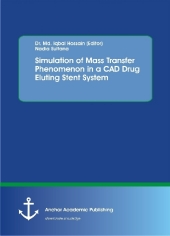 Neuerscheinungen 2017Stand: 2020-02-01 |
Schnellsuche
ISBN/Stichwort/Autor
|
Herderstraße 10
10625 Berlin
Tel.: 030 315 714 16
Fax 030 315 714 14
info@buchspektrum.de |

Md. Iqbal Hossain, Nadia Sultana
(Beteiligte)
Simulation of Mass Transfer Phenomenon in a CAD Drug Eluting Stent System
Herausgegeben von Hossain, Md. Iqbal
2017. 132 S. 38 Abb. 220 mm
Verlag/Jahr: ANCHOR ACADEMIC PUBLISHING 2017
ISBN: 3-9606716-6-0 (3960671660)
Neue ISBN: 978-3-9606716-6-4 (9783960671664)
Preis und Lieferzeit: Bitte klicken
Coronary artery disease is the most common type of heart diseases and the leading cause of death worldwide due to heart disease. It occurs when the arteries that supply blood to the heart become narrowed or blocked by a buildup of cholesterol and other material at the inner wall of the artery. Limitation of blood flow to the heart causes ischemia of the myocardial cells. Myocardial cells may die from lack of oxygen and this is called a myocardial infarction - or more commonly: a heart attack.
Treatment options include medication, surgery or catheter-based procedures. Several types of catheter-based procedures are available. During balloon angioplasty, a special balloon catheter is passed into the narrowed segment of the artery and expands the balloon, which thus opens the artery and compresses the blockage against the wall of the artery. Stents are very small metal mesh-tubes that can be inserted via a balloon catheter into the narrowed segment of the artery. When the balloon is inflated, the stent expands and is embedded into the artery vessel wall, which thus opens the previously narrowed segment of artery. The balloon is then deflated and removed along with the catheter, and the stent is left behind to serve as a metal framework for the artery. In case of drug eluting stents a certain amount of anti-flammating drug is loaded in the coating over the base stent. This drug is released at the wall of diseased artery so that restenosis cannot take place at the place of artery where the stent has been implanted.
In this thesis a drug eluting stent was studied where there was a biodegradable coating over a bare metal stent in which there was some amount of therapeutic drug. The degradation of the biodegradable coating layer thickness was determined with respect to time which was actually representing the remaining drug concentration in the coating layer. Then using this variable drug concentration as the drug concentration at initial tissue layer concentration profile of drug in tissue layer with respect to time and position was determined using finite volume algorithm, where this algorithm was coded using MATLAB programming language.
Md. Iqbal Hossain
Editor
Md. Iqbal Hossain obtained a Ph.D. from the School of Chemical and Biomedical Engineering, Nanyang Technological University, Singapore, and has been serving as an Assistant Professor at the Department of Chemical Engineering, Bangladesh University of Engineering and Technology. He is also a Senior Member of the American Institute of Chemical Engineers. His areas of expertise are multiphase flow, hydrodynamics and measurement-computational techniques.
Nadia Sultana
Author
Nadia Sultana obtained her B.Sc. and M.Sc. from the Department of Chemical Engineering, Bangladesh University of Engineering and Technology. She obtained her second M.Sc. from the Department of Chemical Engineering, Texas Tech University. She is currently a Ph.D. Candidate at Texas Tech University. In her first M.Sc. degree, her research focused on the simulation of a 2D mass transfer profile in a CAD drug eluting stent. In her second M.Sc. degree, she worked with a 3D alginate gel micro-bead (LbL surface modified) based microenvironment for 3T3-L1 cell cultures. Currently, she is researching on the process of heterogeneous crystal nucleation for the energetic material 2, 4, 6-trinitrotoluene (TNT).


